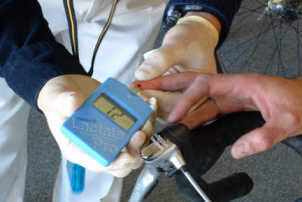As promised. The info you need to make an educated decision about your training.
What is lactate testing?
Lactate testing is a highly scientific, reliable and accurate way of looking inside the body during exercise to see exactly what’s going on physiologically. At its simplest, lactate (a salt) is a by-product of lactic acid, which is produced during exercise, especially at higher intensities. It’s not necessarily bad or good, but it is of key importance when you are looking to improve as an endurance athlete.
To better understand it, some key points are best made from the start because, all lactate testing is not the same and as a consumer you must be careful to learn the facts before you get tested:
Ø Unless you are getting blood lactate measured through blood samples taken during exercise, you are not getting a true lactate test and you cannot get accurate, valid & complete results.
Ø Lactate is a key player in endurance performance. It is far more important than VO2 max as it is directly related to your ability to perform at race pace.
How does blood lactate testing compare to other testing methods?
Lactate testing removes the guesswork and estimation that many other testing methods use and is based solely on the data that your body provides. Anaerobic threshold prediction tests, max heart-rate tests and heart-rate formulas are all based on guesswork and mathematics and as such don’t always give the most accurate results.
After being lactate tested and comparing the results with those from a heart-rate formula or anaerobic threshold prediction test, it’s not uncommon for some athletes to realize that they’ve been training as much as twenty beats per minute out of their optimal range! Suddenly the athlete can see why they were prone to over or under-training, underperformance and constant disappointment.
Almost always, the athlete improves dramatically following lactate testing as for many this is the first time that they get accurate data that allows their true athletic potential to be realized.
With lactate testing your training zones are based on the exact concentration of lactate at certain exercise intensities and the corresponding heart-rates, power outputs and speeds. These are different for everyone. There is no 85% or fat burning zone, just unique and personal results specific only to you based on sound science.
Regularly performing true lactate tests on athletes allows you to:
1. Monitor the balance of the aerobic and anaerobic systems
2. See how your body has adapted to training
3. Allow your body to tell you what training it needs
4 Develop accurate training parameters to bring about optimal progress for you
How can a lactate test help you?
Lactate testing is vital for the optimal development of an endurance athlete. At its best, it gives you precise heart-rates and training parameters like power output and speeds that are not available from any other method. Furthermore, you learn what training works for you and also learn what doesn’t work. It saves you from repeating mistakes and wasting time. For example, imagine getting 6 weeks in to a 12 week training program and doing a repeat lactate test. Imagine that the test tells you that your aerobic system has not improved sufficiently enough for the planned increase in volume that you had in mind. That’s information that you need to know. You can now change your training plan to reflect what you’ve learned, so that you continue to progress over the next 6 weeks and so that your racing experience is more successful.
What if you hadn’t done the test?
Chances are, you’d have ploughed through the increased mileage, overstressing an already weak and undeveloped aerobic system and ended up getting slower and slower, even over-trained. The race would pass miserably and you’d be left wondering what happened.
Is lactate testing only for elite athletes?
Lactate testing is just as important for the Novice athlete as it is for the Elite athlete. If you are genetically gifted, you can get to high level in endurance sports based on what you were born with. At the elite level, lactate testing helps refine training and improve already high standards. At the Novice or Age Grouper level, genetic talent is limited so you need to maximize what you have.
With blood lactate testing you optimize your training so that every second counts and you maximally develop your potential to its highest possible level.
Can you improve without lactate testing?
Of course you can, but how much guesswork are you willing to involve and how much time do you have to waste? Let’s face it - training is hard work. It’s not always fun so you want to guarantee that what you do works for you optimally. You want to make the most of the time that you have available. You can wander through the various books and pick up new ideas and try things but the reality is that the fastest way forward to peak performance, National team qualification, Hawaii ironman qualification and everything you want from your sport, is through rapid and continual development. That comes from good planning and monitoring the success of your training.
Sifting through the science, so you don’t have to. we are: The Gait Guys




















